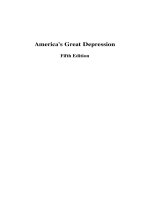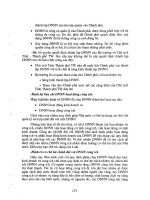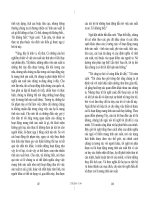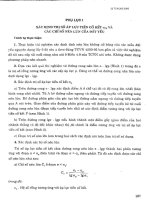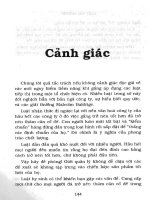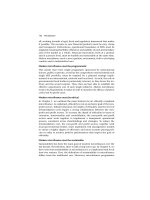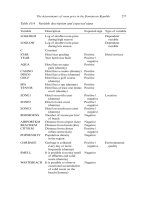America’s Great Depression phần 10 pdf
Bạn đang xem bản rút gọn của tài liệu. Xem và tải ngay bản đầy đủ của tài liệu tại đây (108.37 KB, 48 trang )
324
America’s Great Depression
lenient, yet in many areas the courts would not enforce foreclosures
for insurance companies, enabling many borrowers arrogantly to
refuse to pay. Minnesota forbade foreclosures on farms or homes
for several years.1
Most important of the attacks on creditors’ property occurred
during the currency crisis that marked the end of the Hoover term.
After the election, as the new Presidential term approached, people grew more and more apprehensive, and properly so, of the
monetary policies of the incoming president. Dark rumors circulated about the radicalism of Roosevelt’s advisers, and of their willingness to go off the gold standard. Consequently, not only did
gold “hoarding” by foreigners develop momentum, but even gold
hoarding by domestic citizens. For the first time in the depression,
American citizens were beginning to lose confidence in the dollar
itself. The loss of confidence reached its apogee in February, 1933,
the month before the Roosevelt inaugural. In that one month, the
monetary gold stock fell by $173 million, and money in circulation
increased by the phenomenal amount of $900 million, the reflection of domestic loss of confidence. Money in circulation totaled
$5.4 billion at the end of January, and $6.3 billion by the end of
February. $700 million of this increase was in Federal Reserve
notes, and $140 million in gold coin and gold certificates.
The Federal Reserve did its best to combat this deflationary
pull on bank reserves, but its inflationary measures only served to
diminish confidence in the dollar still further. Thus, in the month
of February alone, Uncontrolled Reserves fell by $1,089 million.
The FRS greatly inflated its Controlled Reserves: bills discounted
more than doubled to increase by $308 million, bills bought multiplied tenfold to increase by $305 million, $103 million of U.S.
governments were purchased. All in all, controlled reserves
increased by $785 million during this month; net reserves fell by
$305 million.
The impact of this fall on the money supply was very strong.
Total currency and deposits fell from $45.4 billion at the end of
1
Theodore Saloutos and John D. Hicks, Agricultural Discontent in the Middle
West, 1900–1939 (Madison: University of Wisconsin Press, 1951), p. 448.
The Close of the Hoover Term
325
1932 to $41.7 billion at mid-1933. Total money supply fell from
$64.72 to $61.61 billion over 1933, and all or more of this fall took
place in the first half of the year. 2 A more sensitive measure of
change, net demand deposits and time deposits at weekly reporting
member banks in 101 cities, totaled $16.8 billion on February 22,
and fell to $14.1 billion by March 8. Bank failures skyrocketed during this period. The number of commercial bank failures increased
from 1,453 in 1932 to 4,000 in 1933 (most of which took place in
the first quarter), with deposits of failed banks increasing from
$706 million to $3.6 billion in the same period.3 Thus, despite the
gigantic efforts of the Fed, during early 1933, to inflate the money
supply, the people took matters into their own hands, and insisted
upon a rigorous deflation (gauged by the increase of money in circulation)—and a rigorous testing of the country’s banking system
in which they had placed their trust.
The reaction to this growing insistence of the people on claiming their rightful, legally-owned property, was a series of vigorous
attacks on property right by state after state. One by one, states
imposed “bank holidays” by fiat, thus permitting the banks to stay
in business while refusing to pay virtually all of the just claims of
their depositors (a pattern that had unfortunately become almost
traditional in America since the Panic of 1819). Nevada had begun
the parade as early as October, 1932, but only 9 out of 20 banks
2
Total monetary contraction from June, 1929 to the end of 1933 was 16 percent, or 3.6 percent per annum.
3
An apt commentary on whether time deposits are money is this statement by
two St. Louis bankers:
Actually all of us were treating our savings and time deposits as demand
deposits and we still do . . . we still pay our savings depositors on demand.
It is significant that the heavy runs on banks were engineered by savings
and time depositors. When the trouble was at its height in January, 1933,
practically every bank in St. Louis faced heavy withdrawals from . . . savings depositors and had a minimum of diffculty with the checking depositors. This was true throughout most of the country.
F.R. von Windegger and W.L. Gregory, in Irving Fisher, ed., 100% Money
(New York: Adelphi Press, 1935), pp. 150–51.
326
America’s Great Depression
took advantage of the state holiday, the others remaining open.4
Louisiana declared a brief holiday for the hard-pressed New
Orleans banks in early February, but the bank holiday movement
began in earnest with the proclamation of an eight-day holiday on
February 14, 1933, by Governor William Comstock of Michigan.5
This action precipitated the bank runs and deflation of the latter
part of February. For if one state could, with impunity, destroy
property right in this manner, then others could—and did—and
depositors began an intense scramble to take their money out of
the banks.
It is at times like these that the speciousness of apologists for our
banking system hailing fractional reserves as being as sound as the
building of bridges—on estimate that only some inhabitants of the
area will cross it at any one time—becomes patently evident. For
no one has a legal property ownership in the bridge, as they do in
their bank deposits. At times like these, also, it becomes clear that
bank deposits are not really money—even on a paper, let alone a
gold standard—but mere money-substitutes, which serve as money
ordinarily, but reveal their true identity when nationwide confidence begins to collapse.
On the request of bankers for government to save them from
the consequences of their own mistakes, state after state, beginning
4
See Jesse H. Jones and Edward Angly, Fifty Billion Dollars (New York:
Macmillan, 1951), pp. 17ff.
5
Detroit had especially overexpanded during the boom, and frantic efforts by
Hoover and his administration, along with Detroit industrialists and New York
banks, to save the leading Detroit banks, had foundered on the devotion to private enterprise and true private responsibility of Henry Ford and of Michigan’s
Senator Couzens, both of whom refused to agree to subsidize unsound banking.
See ibid., pp. 58–65. Also see Lawrence E. Clark, Central Banking Under the
Federal Reserve System (New York: Macmillan, 1935), pp. 226ff.; Benjamin M.
Anderson, Economics and the Public Welfare (New York: D. Van Nostrand, 1949),
pp. 285ff. Dr. Anderson, supposedly an advocate of laissez-faire, sound money, and
property right, went so far in the other direction as to chide the states for not
going further in declaring bank holidays. He declared that bank moratoria should
have applied to 100 percent, not just 95 percent, of bank deposits, and he also
attacked the Clearing House for failing to issue large quantities of paper money
during the crisis.
The Close of the Hoover Term
327
with Indiana, declared moratoria and bank holidays. Governor
Ritchie of Maryland declared a three-day bank holiday on February 24. On February 27, the member banks of the Cleveland
Clearing House Association decided arbitrarily to limit withdrawals from all their branches, and no state officials acted to stop
this blatant infringement of property right. They were promptly
followed by Akron and Indianapolis banks. On February 27, the
Ohio, Pennsylvania, and Delaware legislatures authorized the state
banking officials to restrict the right of withdrawal of deposits.
The states adopted this procedure quickly and virtually without
debate, the laws being rammed through on the old political excuse
that the taxpaying and voting public must be kept in ignorance of
the situation in order to prevent panic.6 In such a manner do the
“people’s representatives” characteristically treat their supposed
principals.
One of the ironic aspects of this situation was the fact that many
national banks, which had worked hard to keep themselves in an at
least relatively sound position, did not want to avail themselves of
the special privilege of bank holiday, and had to be coerced into
doing so. As Willis puts it:
[i]n many cases, the national banks . . . had no wish to
join in the holiday provisions of the localities in which
they were situated. They had, in such cases, kept themselves in position to meet all claims to which they might
be subject, and they desired naturally to demonstrate to
depositors and customers their ability to meet and overcome the obstacles of the time, both as a service to such
customers and as an evidence of their own trustworthiness. There followed what was deemed . . . the necessity
or desirability of coercing . . . the sound banks of the
community into acceptation of the standard thought
6
See H. Parker Willis, “A Crisis in American Banking,” in Willis and John M.
Chapman, eds., The Banking Situation (New York: Columbia University Press,
1934), pp. 9ff. The holiday laws either (a) forbade banks to redeem the funds of
depositors, or (b) permitted the banks to choose the proportion of claims that
they would pay, or (c) designated the proportion of claims the depositors might
redeem.
328
America’s Great Depression
essential for the less liquid and less well-managed institutions.7
By March 4, every state in the Union had declared a bank holiday, and the stage was set for President Roosevelt’s dramatic and
illegal closing of all the banks. The stage was set, by the way, with
the full collaboration of the outgoing administration; in late February, Congress, with the acquiescence of President Hoover,
passed a law permitting national banks to cooperate with state
bank holidays. And the Comptroller of the Currency obligingly
issued a proposed draft of a uniform bank holiday act to aid the
various state legislatures in drafting their bills.
President Roosevelt closed down all the banks throughout the
nation for an entire week, from March 6 to 13, with many banks
remaining closed even longer. 8 It was a final stroke of irony that
Roosevelt’s only semblance of legal ground for this decree was the
Trading with the Enemy Act of World War I! Restrictions against
so-called “hoarding” were continued afterward, and much hoarded
gold returned to the banks following a Federal Reserve threat to
publish a list, for full public scorn, of the leading “gold hoarders.” 9
It soon became clear that, with the advent of the Roosevelt administration, the American gold standard was doomed.
There have been a great many recriminations, particularly from
the Hoover camp, about Roosevelt’s “failure to cooperate,” when
he was President-elect, in solving the banking crisis. Certainly it is
true that fear of Roosevelt’s impending monetary radicalism, and
Senator Glass’s investigations forcing Charles E. Mitchell to resign
as President of the National City Bank, contributed to the banking
7
Ibid., p. 11. In New York, the pressure for bank closing came from the
upstate, rather than from the Wall Street, banks.
8
See ibid. Michigan’s Governor Comstock, who had begun the furor, naturally extended his holiday beyond the original eight-day period.
9
Lest it be thought that Hoover would never have contemplated going this
far, Jesse Jones reports that Hoover, during the banking crisis, was seriously contemplating invoking a forgotten wartime law making hoarding a criminal offense!
Ibid., p. 18.
The Close of the Hoover Term
329
panic. But the important fact is that the banking system had
arrived at a critical impasse. Usually, in the placid course of events,
radical (in the sense of far-reaching) economic reforms, whether
needed or not, meet the resistance and inertia of those who drift
with the daily tide. But here, in the crisis of 1933, the banks could
no longer continue as they were. Something had to be done.
Essentially, there were two possible routes. One was the course
taken by Roosevelt; the destruction of the property rights of bank
depositors, the confiscation of gold, the taking away of the people’s
monetary rights, and the placing of the Federal Government in
control of a vast, managed, engine of inflation. The other route
would have been to seize the opportunity to awaken the American
people to the true nature of their banking system, and thereby
return, at one swoop, to a truly hard and sound money.
The laissez-faire method would have permitted the banks of the
nation to close—as they probably would have done without governmental intervention. The bankrupt banks could then have been
transferred to the ownership of their depositors, who would have
taken charge of the invested, frozen assets of the banks. There
would have been a vast, but rapid, deflation, with the money supply falling to virtually 100 percent of the nation’s gold stock. The
depositors would have been “forced savers” in the existing bank
assets (loans and investments). This cleansing surgical operation
would have ended, once and for all, the inherently bankrupt fractional-reserve system, would have henceforth grounded loans and
investments on people’s voluntary savings rather than artificiallyextended credit, and would have brought the country to a truly
sound and hard monetary base. The threat of inflation and depression would have been permanently ended, and the stage fully set
for recovery from the existing crisis. But such a policy would have
been dismissed as “impractical” and radical, at the very juncture
when the nation set itself firmly down the “practical” and radical
road to inflation, socialism, and perpetuation of the depression for
almost a decade.
President Hoover, of course, did not even come close to advocating the hard money, laissez-faire policy. Hoover and his partisans have woven the myth that all would have been well if only
330
America’s Great Depression
Roosevelt had “cooperated” with Hoover before the inaugural, but
just what was this projected cooperation to be? Largely, a joint
agreement on partial or total national bank holidays, and on a
Hoover proposal for temporary federal guarantees of bank
deposits—inflationist and statist measures which Roosevelt was
soon to adopt.10, 11 Furthermore, as a pièce de résistance, agitation for
going off the gold standard kept proceeding from high up in the
Hoover administration itself; specifically from Secretary of Treasury Mills and from Undersecretary Arthur Ballantine. 12
WAGES, HOURS, AND EMPLOYMENT
DURING THE DEPRESSION
Mr. Hoover left office in March, 1933, at the very depth of the
greatest depression in American history. Production had fallen by
more than one-half: industrial production had been at an index of
114 in August, 1929, and then fell to 54 by March, 1933. Unemployment was persisting at nearly 25 percent of the labor force,
10
There was a recurring tendency on the part of Hoover and his colleagues to
blame the whole depression on a plot by Hoover’s political enemies.
Hoover attributed part of the currency crisis to Communists spreading distrust of the American monetary system (it is remarkable that Communists were
needed for distrust to arise!); and Simeon D. Fess, Chairman of the Republican
National Committee, said quite seriously in the fall of 1930:
Persons high in Republican circles are beginning to believe that there is
some concerted effort on foot to utilize the stock market as a method of
discrediting the administration. Every time an administration official
gives out an optimistic statement about business conditions, the market
immediately drops.
Edward Angly, comp., Oh Yeah? (New York: Viking Press, 1931), p. 27.
11
Another Hoover contribution to these times was a secret attempt to stop the
press from printing the full truth about the banking crisis, and about views hostile to his administration. See Kent Cooper, Kent Cooper and the Associated Press
(New York: Random House, 1959), p. 157.
12
In fact, Ballantine recently wrote, rather proudly: “the going off [gold] cannot be laid to Franklin Roosevelt. It had been determined to be necessary by
Ogden Mills, Secretary of the Treasury, and myself as his Undersecretary, long
before Franklin Roosevelt took office.” New York Herald-Tribune (May 5, 1958): 18.
The Close of the Hoover Term
331
and gross national product had also fallen almost in half. Hardest
hit was investment, especially business construction, the latter
falling from about $8.7 billion in 1929 to $1.4 billion in 1933. This
is not the only indication that the depression hit hardest in the capital goods industries.
The index of non-durable manufacturing production fell from
94 to 66 from August, 1929, to March, 1933—a decline of 30 percent; the index of durable manufactures fell from 140 to 32, in the
same period, a decline of 77 percent. Factory employment fell by
42 percent; pig iron production decreased by an astounding 85
percent; the value of construction contracts fell from July, 1929, by
an amazing 90 percent, and the value of building permits by 94
percent. On the other hand, department store sales fell by less than
50 percent over the period. Taking durable goods industries (e.g.,
building, roads, metals, iron and steel, lumber, railroad, etc.) Col.
Leonard P. Ayres estimated that their total employment fell from 10
million in 1929 to 4 million in 1932–1933, while employment in
consumer goods industries (e.g., food, farming, textiles, electricity,
fuel, etc.) only fell from 15 million to 13 million in the same
period.13 Stock prices (industrials) fell by 76 percent during the
depression, wholesale prices fell by 30 percent, and the total
money supply declined by one-sixth.
What of wage rates? We saw that the Hoover policies managed
to keep wage rates very high during the first two years of the
depression. By 1932, however, with profits wiped out, the pressure
became too great, and wage rates fell considerably. Total fall over
the 1929–1933 period, however, was only 23 percent—less than
the decline in wholesale prices. Therefore, real wage rates, for the
workers still remaining employed, actually increased. An excellent
inquiry into the wage-employment problem during the depression
has been conducted by Mr. Sol Shaviro, in an unpublished essay. 14
13
Leonard P. Ayres, The Chief Cause of This and Other Depressions (Cleveland,
Ohio: Cleveland Trust, 1935), pp. 26ff.
14
Sol Shaviro, “Wages and Payroll in the Depression, 1929–1933,” (Unpub.
M.A. thesis, Columbia University, 1947).
332
America’s Great Depression
Shaviro shows that in 25 leading manufacturing industries, the following was the record of monetary, and real, average hourly earnings during these years.
We thus see that money wage rates held up almost to the prosperity-par until the latter half of 1931, while real wage rates actually increased by over 10 percent. Only then did a monetary wage
decline set in, but still without a very appreciable reduction in real
wage rates from the 1931 peak. It should here be noted that, in
contrast to Keynesian warnings, prices fell far less sharply after
wage rates began to drop, than before. From July, 1929, to June,
1931, wholesale prices fell from 96.5 to 72.1, or at a rate of fall of
1 per month, while from June, 1931, to February, 1933, prices fell
to 59.8, or at a rate of .65 per month.15
TABLE 10
AVERAGE H OURLY EARNINGS IN
25 MANUFACTURING INDUSTRIES
(100 = 1929)
Monetary
June, 1929
December, 1929
June, 1930
December, 1930
June, 1931
December, 1931
June, 1932
December, 1932
March, 1933
Real
100.0
100.0
100.0
98.1
96.1
91.5
83.9
79.1
77.1
100.7
99.8
102.7
105.3
111.0
110.1
108.2
105.7
108.3
Shaviro points out that businessmen, particularly the large
employers, were taken in by the doctrine that they should pursue
an “enlightened” high-wage policy, a doctrine not only fed to them
by the veiled threats of the President, but also by economists and
15
See C.A. Phillips, T.F. McManus, and R.W. Nelson, Banking and the Business
Cycle (New York: Macmillan, 1937), pp. 231–32.
The Close of the Hoover Term
333
labor leaders, on the grounds of “keeping up purchasing power” to
combat the depression. The drop in wage rates had been more
extensive and far more prompt in the far milder 1921 depression;
in fact, even money wage rates rose slightly until September, 1930. 16
More wage cuts took place in smaller than in larger firms, since the
smaller firms were less “enlightened,” and furthermore, were not
as fully in the public (and governmental) view. Furthermore, executive, and then other, salaries were generally reduced considerably
more than wage rates. In fact, one reason that the eventual wage
declines proved ineffective was the pseudo-humanitarian morality
that governed the cuts when finally made: thus, reductions were
automatically graduated in proportion to the income brackets of
the workers, the higher brackets suffering greater declines. And
reductions were often softened for workers with dependents. In
short, instead of trying to adjust wage rates to marginal productivities, as was desperately needed, the firms allocated the “loss in
income on the most just and equitable [sic] basis . . . [actuated by
the] desire to make the burden of reduced income fall as lightly as
possible on those least able to suffer the loss.” In short, each man
was penalized according to his ability and subsidized according to
the need for which he had voluntarily assumed the responsibility
(his dependents).
It was typical that executive salaries were the ones cut most
promptly and severely, even though the great unemployment
problem was not among the executives but among rank-and-file
workers. As a result of this tragically wrong-headed policy, the
wage cuts certainly stirred up little worker resentment, but also did
little to help unemployment. In sum, management’s attitude
looked not for what “reduction can most easily be made, but rather
how can necessary payroll economies be accomplished with the
least hardship for all concerned.” This policy only aggravated the
16
“Maintenance of higher wage rates caused many firms to discharge workers
rather than appear as slackers by cutting wages, although they might have been
able to continue operations if they had made such reductions.” Dale Yoder and
George R. Davies, Depression and Recovery (New York: McGraw-Hill, 1934), p. 89.
334
America’s Great Depression
general hardship, as will always happen when business strays from
its proper goal of maximizing profits.17
While real average hourly earnings rose, actual hours worked in
industry fell drastically during the depression. Weekly hours averaged over 48 in 1929, and fell to less than 32 by mid-1932. In no
previous depression had hours worked fallen by more than 10 percent. This was a form of reduced employment caused by the highwage policy, a form, as we have seen, particularly recommended by
the Hoover administration. As a result of the fall in hours worked
and in money wage rates, average weekly earnings fell by over 40
percent during the depression, and real weekly earnings fell by
over 30 percent. But hardest hit were the unemployed, the percentage of whom rose to 25 percent by 1932–1933, and reached 47
percent in the selected manufacturing industries. The fall in manhours worked, combined with the fall in average hourly earnings,
caused a truly precipitate drop in total factory payrolls—the base of
that very “purchasing power” that the “enlightened” policy was supposed to sustain. Total payroll fell by over 29 percent in 1930, a year
when money wage rates (average hourly earnings) rose to a higher
level than 1929, and payroll had fallen by almost 71 percent by
March, 1933. Real payroll fell by over 60 percent in the same period.
The purchasing power theorists often declaim that the key to
prosperity is national income going more to employees and less to
profits: these conditions were filled to their hearts’ content during
the depression. For aggregate profits were negative during 1932
and 1933.
Although unions were not particularly important in these years,
amounting to only 6 percent of the labor force, Professor Levinson has shown that unions maintained higher wage rates for their
employed workers than did comparable non-union workers.18 This
17
National Industrial Conference Board, Salary and Wage Policy in the
Depression (New York: Conference Board, 1933), pp. 31–38.
18
Harold M. Levinson, “Unionism, Wage Trends, and Income Distribution:
1914–1947,” Michigan Business Studies (June, 1951): 34–47. Hoover and Secretary
Lamont tried to induce the nation’s industrialists to be more favorable to unions,
The Close of the Hoover Term
335
demonstrates the power of unions to maintain money wage rates
during a depression, thereby aggravating the unemployment problem, and reinforcing the effects of Hoover’s injunctions and
“enlightened” economic theory. Wage rates of selected union
workers fell only 6–12 percent over the 1929–1932 period, while
the rates of non-union workers fell by 14–36 percent.
Levinson points out that there is a close relationship between
the strength of the union and the maintenance of wage rates in
each specific industry. Thus, the union in the men’s clothing industry had been greatly weakened in the 1920s by moves of industry
from union to non-union areas, so that it had to accept wage
reductions during the depression “to protect the solvency of the
organized employees”; wage rates in this industry fell by 31 percent during the 1929–32 period.
Sharing-the-work by putting employees on reduced time was
another favorite panacea of the Hoover administration. Yet, in
1931 the President’s Emergency Committee for Employment
reported that, in a sample of manufacturing, plants with under
1,000 employees suffered an unemployment problem in 75 percent
of the cases, whereas 96 percent of the plants with over 5,000
workers suffered from unemployment. Eighty-eight percent of the
larger firms had engaged in work-sharing, while only 53 percent of
the smaller firms did so. In a business and industrial conference of
August 26, 1932, Hoover reported that work-sharing had been
used for hundreds of thousands of workers.
The Conference appointed a subcommittee headed by Walter
Teagle, President of Standard Oil of New Jersey, to urge more
work-spreading, in hopes of putting two million people back to
work. Standard Oil set an example by hiring 3000 more workers in
addition to its total of 23,000. The slogan adopted was: “job security
by job sharing.” In September, William J. Barrett, of the President’s
Organization on Unemployment Relief, delivered a comprehensive
report on work-spreading. Barrett admitted that “management has
by urging them, during 1930 and 1931, to meet at a formal conference with leaders of organized labor. See James O. Morris, “The A.F. of L. in the 1920s: A
Strategy of Defense,” Industrial and Labor Relations Review (July, 1958): 577–78.
336
America’s Great Depression
undergone increased costs in providing employment for additional
workers.” He further revealed that the largest proportion of worksharing occurred in the most distressed industries: i.e., the capital
goods industries. This illustrates the role that work-sharing played
in aggravating and perpetuating unemployment. Thus, in a sample
of industries, the largest proportion of part-time workers occurred
in such fields as machinery (84.9 percent), rubber, iron, and steel
(79.3 percent), metals, stone, clay, and glass, while the smallest
proportion occurred in railroads (22.3 percent), foods (26.6 percent), retail and wholesale, and commercial establishments (20.4
percent). The average part-time proportion for the entire sample
was 56.1 percent.19
CONCLUSION: THE LESSONS
OF MR. HOOVER’S RECORD
Mr. Hoover met the challenge of the Great Depression by acting quickly and decisively, indeed almost continuously throughout
his term of office, putting into effect “the greatest program of
offense and defense” against depression ever attempted in America.
Bravely he used every modern economic “tool,” every device of progressive and “enlightened” economics, every facet of government
planning, to combat the depression. For the first time, laissez-faire
was boldly thrown overboard and every governmental weapon
thrown into the breach. America had awakened, and was now
ready to use the State to the hilt, unhampered by the supposed
shibboleths of laissez-faire. President Hoover was a bold and audacious leader in this awakening. By every “progressive” tenet of our
day, he should have ended his term a conquering hero; instead he
left America in utter and complete ruin—a ruin unprecedented in
length and intensity.
What was the trouble? Economic theory demonstrates that
only governmental inflation can generate a boom-and-bust cycle,
and that the depression will be prolonged and aggravated by inflationist and other interventionary measures. In contrast to the myth
19
Monthly Labor Review 35 (1932): 489ff. and 790ff.
The Close of the Hoover Term
337
of laissez-faire, we have shown in this book how government intervention generated the unsound boom of the 1920s, and how
Hoover’s new departure aggravated the Great Depression by massive measures of interference. The guilt for the Great Depression
must, at long last, be lifted from the shoulders of the free-market
economy, and placed where it properly belongs: at the doors of
politicians, bureaucrats, and the mass of “enlightened” economists.
And in any other depression, past or future, the story will be the
same.
I
Appendix: Government and the
National Product, 1929–1932
n footnote 21 of Chapter 9, we explain how we arrive at our
estimate of the degree of government depredation on the private national product. The critical assumption is the challenge
to the orthodox postulate that government spending, ipso facto,
represents a net addition to the national product. This is a clearly
distorted view. Spending only measures value of output in the private economy because that spending is voluntary for services rendered. In government, the situation is entirely different: government acquires its money by coercion, and its spending has no necessary relation to the services that it might be providing to the private sector. There is no way, in fact, to gauge these services. Furthermore, every government-conscripted dollar deprives the citizen of expenditures he would rather have made. It is therefore far
more realistic to make the opposite assumption, as we do here, that
all government spending is a clear depredation upon, rather than
an addition to, private product and private output. Any person who
believes that there is more than 50 percent waste in government will
have to grant that our assumption is more realistic than the standard one.
To estimate the extent of government depredation on private
product, we first find private product by deducting “product” or
“income” originating in government and “government enterprise”—i.e., the payment of government salaries—from Gross
National Product. We now have the Gross Private Product. Government depredations upon this GPP consist of the resources that
339
340
America’s Great Depression
government drains from the private sector, i.e., total government
expenditures or receipts, whichever is the higher. This total subtracted from the GPP yields the private product remaining in private hands, which we may call PPR. The percentage of government depredation to gross private product yields an estimate of the
burden of government’s fiscal operations on the private economy. 1
If government expenditure is larger than receipts, then the
deficit is a drain on private resources—whether financed by issuing
new money or by borrowing private savings—and therefore the
expenditure figure is chosen as a measure of government depredation of the private sector. If receipts are larger, then the surplus
drains the private sector through taxes, and receipts may be considered the burden on the private sector. 2
One significant problem created by the vagaries of the official
statistics—fortunately, again, a problem not significant for our
period—is that the official statistics lump together the bulk of the
spending of government enterprises (roughly, the government
agencies that charge fees) in the private, rather than the governmental, sector. There are, therefore, no figures available for the
1
It is conventionally argued, e.g., by Professor Due, that we should not
include government transfer payments, e.g., relief payments, in any such expenditures deducted because transfer payments are not included in the original GNP
figure. But the important consideration is that taxes (or deficits) to finance transfer payments do act as a drain on the national product, and therefore must be subtracted from GPP to yield PPR. Due claims that, in gauging the relative size of
governmental and private activity, transfer payments should not be included
because they “merely shift purchasing power” from one set of private hands to
another, without the government’s using up resources. But this “mere shift” is just
as much a burden upon the private producers, just as much a shift from voluntary
production to state-created privilege, as any other governmental expenditure. It
is a government-induced using of resources. John F. Due, Government Finance
(Homewood, Ill.: Richard D. Irwin, 1954), pp. 64, 76–77.
2
A surplus slightly overestimates the extent of depredation if it is used to
deflate the money supply, and government expenditures slightly overstate the
extent of depredation by counting in the amount of government taxes levied on
government bureaucrats themselves. The amount of distortion is slight, however,
particularly for the 1929–1932 period, and is less than the distortion of using
GNP instead of GPP, and thus counting governmental payment of salaries as
equivalent to the “product” of government.
Appendix
341
total spending or total receipts of government enterprises—although
there are separate figures for the salaries paid by, the “income originating in,” government enterprises. Below, we will present very
rough estimates for government enterprises for these years.
Furthermore, we do not, as do the Department of Commerce
accounts of government expenditures, deduct government interest
received from interest paid by government, to arrive at a “net interest
paid” figure. On the contrary, the full amount paid by government is
deducted from private resources and must therefore be included;
while “interest received” is a receipt from the private sector, and
should be included in the estimation of government receipts.
We are presenting here the figures not only for gross product, but
also for net product, which are also of interest. Net National Product is Gross National Product minus depreciation and other capital
consumption allowances, and if we consider private product as net
income without drain on the value of capital, then we should estimate
the percentage of government depredation on net private product.3
Table I presents Gross National Product and Net National Product in current prices. (Figures in this and following tables are from
TABLE I
N ATIONAL P RODUCT
($ billions)
Gross National
Product
1929
104.4
95.8
1930
91.1
82.6
1931
76.3
68.1
1932
3
Net National
Product
58.5
50.9
Of course, official figures are not always accurate estimates of true depreciation. For a cogent discussion of the advantages and disadvantages of using net or
gross measures of the governmental burden on the economy, see The Tax Burden
In Relation To National Income and Product (New York: Tax Foundation, 1957).
342
America’s Great Depression
U.S. Income and Output, Department of Commerce, November
1958; and National Income, 1954 Edition, Department of Commerce.)
Our next step is to find the gross product of government and
government enterprises, or “income originating in government
and government enterprises.” Table II presents these figures for
Federal, and for state and local, government and government
enterprises.
TABLE II
INCOME ORIGINATING IN GOVERNMENT
($ billions)
Fed.
Govt.
1929
1930
1931
1932
Fed.
Govt.
Ent.
State &
Local
Govt.
State &
Local
Govt. Ent.
Total
Govt. and
Govt. Ent.
0.9
0.9
0.9
0.9
0.6
0.6
0.6
0.5
3.4
3.6
3.7
3.6
0.2
0.2
0.2
0.2
5.1
5.3
5.4
5.2
Deducting the total figure for income originating in government and government enterprises, from GNP, we arrive at Gross
Private Product (and from NNP, we arrive at Net Private Product). This is shown in Table III.
TABLE III
PRIVATE PRODUCT
($ billions)
GNP
1929
1930
1931
1932
104.4
91.1
76.3
58.5
NNP
95.8
82.6
68.1
50.9
Total Inc.
Orig. in
Govt. &
Govt. Ent.
Gross
Private
Prod.
5.1
5.3
5.4
5.2
99.3
85.8
70.9
53.3
Net
Private
Prod.
90.7
77.3
62.7
45.7
Appendix
343
Table IV presents our estimates for government expenditures,
not including government enterprises. As we have indicated above,
“interest received,” which had been deducted from “interest paid”
by government to arrive at the Department of Commerce figure
for government expenditures, was re-included; also, for similar
reasons, “surplus of state and local government enterprises,” which
the Department deducted from its aggregate of state and local government spending, was re-included in our estimates.
TABLE IV
GOVERNMENT EXPENDITURES
($ billions)
Fed.
Expends.
State & Local
Expends.
Total Govt.
Expends.
1929
2.9
8.2
11.1
1930
3.1
8.9
12.0
1931
4.4
8.9
13.3
1932
3.4
8.0
11.4
Estimates of the expenditure of government enterprises are
divisible into two parts: income originating (i.e., employee
salaries), which are available from the Department of Commerce,
and purchases from business, which are not available at all. Neither
the Department of Commerce nor the Treasury has any figures
available for purchases from business. The only estimates we may
obtain, therefore, must be highly sketchy and arbitrary. Professor
Fabricant has prepared figures for the fiscal year 1932 (we have so
far been dealing in calendar years) of the total purchases from business by federal and state and local governments, including government enterprise. 4 Fabricant estimates total Federal purchases from
4
Solomon Fabricant and Robert E. Lipsey, The Trend of Government Activity
in the United States Since 1900 (New York: National Bureau of Economic
Research, 1952), pp. 222–34.
344
America’s Great Depression
business, general government and government enterprise, as $1.02
billion for 1931–32. The average of the Department of Commerce
figure of Federal government (general) purchases from business
for 1931 and 1932 is $.54 billion. We may therefore estimate the
expenditure by Federal enterprises on goods from business as $.48
billion for 1931–32.
On the state and local level, Fabricant estimates a total of $4.08
billion spent by government and government enterprise on business products in 1931–32; the average of 1931–1932 for general
state and local government purchases from business is $3.48 billion
(Department of Commerce). This leaves as the estimate for
1931–1932 of purchases of government enterprises, state and local,
from business at $.60 billion.
Unfortunately, Fabricant presents no figures for any other years
for our period on the state and local level. For Federal purchases
from business, Fabricant estimates the total, for government and
government enterprise, at $.88 billion for fiscal 1929. Now, unfortunately, we have no data for 1928; using calendar year 1929, therefore, we obtain $.36 billion as the Department of Commerce estimate for Federal government (general) purchases. Subtracting this
from the Fabricant figure, we obtain a rough estimate of $.52 billion
for the purchases of Federal enterprises from business during 1929.
To extrapolate these sketchy figures into estimates of federal, and
state and local, government enterprises for each of these years is certainly arbitrary, but it would just as certainly be more arbitrary if we
simply ignored the problem altogether, and permitted government
enterprises to remain partially ensconced in the private sector. We
will therefore assume that, for each of our years, Federal enterprises
spent $.5 billion on the products of business, while state and local
enterprises spent $.6 billion. Our estimates for the expenditures of
government enterprises are then as follows in Table V.
The grand total of expenditures for government and government enterprises for these years is therefore as follows in Table VI.
What were governmental receipts during these years? Here we
may take the Department of Commerce data, adding to them for both
federal and state and local, “interest received.” As for government
Appendix
345
TABLE V
E XPENDITURES OF GOVERNMENT E NTERPRISES
($ billions)
Purch.
from
Bus.
Fed.
Income
Orig.
Fed.
1929
1930
1931
1932
0.6
0.6
0.6
0.5
0.5
0.5
0.5
0.5
Income
Orig.
State &
Local
0.2
0.2
0.2
0.2
Purch.
from
Bus.
S. & L.
0.6
0.6
0.6
0.6
Total
Expend.
Govt.
Enterp.
1.9
1.9
1.9
1.8
TABLE VI
EXPENDITURES OF GOVERNMENT AND GOVERNMENT ENTERPRISES
($ billions)
Federal
1929
1930
1931
1932
State
and Local
Total
5.2
4.4
3.4
3.0
8.8
9.1
9.0
8.5
14.0
13.5
12.4
11.5
enterprises, we may simply and roughly assume that their receipts
balanced their expenditures, and estimate them in the same way,
except that we know from the Department of Commerce the current surplus of state and local government enterprises, which we
may add to the receipt figure. Total estimated receipts of government and government enterprise are presented in Table VII. It
might be thought that, to arrive at the highest aggregate figure of
government expenditures or receipts for any year, we simply total
federal and state and local receipts, and the same for expenditures, and see which one is the higher. This is not correct, however. Whenever we have independent centers of governmental
346
America’s Great Depression
TABLE VII
R ECEIPTS OF GOVERNMENT AND GOVERNMENT ENTERPRISES
($ billions)
Federal
State
and Local
Total Govt.
1929
5.2
8.8
14.0
1930
4.4
9.1
13.5
1931
3.4
9.0
12.4
1932
3.0
8.5
11.5
activity, the deficits and surpluses of these centers do not cancel
each other in their impact on the private economy. Suppose hypothetically, that, in a given year the Illinois state government has a
fiscal surplus of $200 million, while New York has a deficit of $200
million. If we are interested in a figure for the governmental
impact of New York and Illinois states combined, we do not simply
aggregate receipts and expenditures and compare them. For Illinois’s surplus taxes drain the private sector, and New York’s deficits
also drain the private sector. The ideal step, therefore, is to take
each state’s and each locality’s receipts or expenditures, whichever
is the higher, and add up each of these higher figures, along with
the higher figure for the Federal budget, to estimate the total fiscal impact of all level of government. With the data we have available, we can only do this for state and local on the one hand, and
Federal on the other. 5
Now, at last, in Table VIII, we are ready to estimate the fiscal
“depredations of government” for Federal, and for state and local
authorities (including government enterprises), and compare them
to the data for private product.
We see here, in stark relief, the record of the enormous increase
in the fiscal burden of government during the depression, from
5
Because, in our figures, state and local governments are already lumped
together, our estimates will, from this standpoint, considerably underestimate the
fiscal burden of government on the private sector.
Appendix
347
G OVERNMENT
TABLE VIII
P RIVATE PRODUCT
AND THE
($ billions)
Gross
Private
Prod.
1929
1930
1931
1932
Net
Private
Prod.
99.3
85.8
70.9
53.3
90.7
77.3
62.7
45.7
Fed.
Depred.
State
& Local
Depred.
5.2
4.4
5.5
4.4
Total
Govt.
Depreds.
9.0
9.7
9.7
8.8
14.2
14.1
15.2
13.2
Private Prod.
Remaining (Gross)
Private Prod.
Remaining (Net)
85.1
71.7
55.7
40.1
76.5
63.2
47.5
32.5
1929
1930
1931
1932
Fed.
Depreds.
% of GPP
1929
1930
1931
1932
Total Govt.
Depreds.
% of GPP
5.2
5.1
7.8
8.3
9.1
11.3
13.7
16.5
14.3
16.4
21.5
24.8
Fed.
Depreds.
% of MPP
1929
1930
1931
1932
State
& Local
Depreds.
% of GPP
State
& Local
Depreds.
% of MPP
Total Govt.
Depreds.
% of MPP
5.8
5.7
8.8
9.6
9.9
12.5
15.5
19.3
15.7
18.2
24.3
28.9
1929 to 1932. The percentage of Federal depredations on the private product rose from approximately 5 percent to 8 percent of the
348
America’s Great Depression
GPP, and from 6 percent to 10 percent of the NPP; state and local
depredations rose from 9 percent to 16 percent of the GPP, and
from 10 to 19 percent of the NPP. Total government depredations
rose from 14 percent to 25 percent of GPP, and from 16 percent
to 29 percent of NPP, not far from double the burden!
Index
Abbott, Charles Cortez, 130, 161
Abbott, Charles F., 278
Abbott, Edith, 251, 271
Acceleration principle, 60–68
Acceptances, See Federal Reserve
System
Achinstein, Asher, 251
Addams, Jane, 194
Addis, Charles S., 179
Agricultural Adjustment
Administration, 280
Agricultural Credits Act of 1923,
122, 221
Agriculture
exports of, loans to, 121–22,
129, 138–39, 142, 147, 153,
156, 159, 165, 219–21,
226–27, 241, 258, 271,
299–300, 322
farm holidays, 235
prices, 147, 153, 158–59, 171,
181, 191, 222, 227, 239, 248,
315
Agriculture, Department of, 217,
222, 225
Alabama, 301
Aldrich, Winthrop W., 140, 149,
181, 262
Alexander, Magnus W., 306, 309
Amalgamated Clothing Workers,
282
American Acceptance Council, 128,
155
American Association for Labor
Legislation, 176, 193–94,
196–97, 202, 250
American Bankers’ Association, 244
American Bar Association, 176
American Construction Council,
195
American Cotton Association, 222
American Council of Agriculture,
225
American Council on Education,
179
American Economic Association,
248
Committee on Purchasing
Power, 174
American Engineering Council,
196, 300
American Farm Bureau Federation,
179, 217, 223, 225, 228, 241,
310
American Farm Economic
Association, 179
American Federation of Labor,
174–75, 195–96, 198, 200,
213–14, 241, 244–45, 266,
281–82, 294, 308, 310, 319
American Gas Association, 212
349

